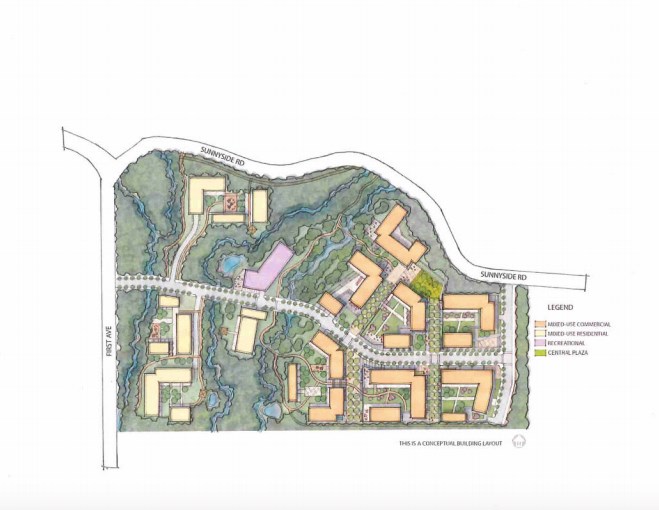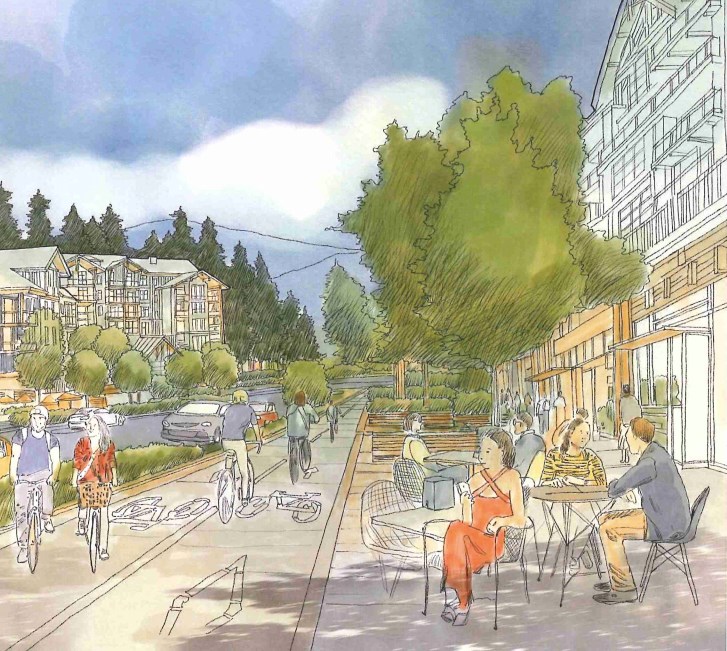A plan to develop a portion of the former Ioco lands in Anmore is in the works and, this week, the village got a good look at what the developer is proposing to build over the next decade and beyond.
Gilic Global Development Management Inc., formerly Brilliant Circle Group, which bought the 230-acre Ioco lands in 2015, is now embarking on a formal process to build a new neighbourhood of more than 4,200 people on a portion of its Anmore property.
(Meanwhile, the Port Moody portion, which includes the old Ioco townsite, is not part of the proposal — although the city, which borders the village, will likely have an interest in the project, especially around traffic. In October, a majority on PoMo council voted to amend the official community plan to limit any future development of the city's portion of the Ioco lands to its current single-family zoning.)
Named Burrard Commons, Gilic's proposed project would include 12-storey apartments in a forested green space with retail and commercial space, with jobs for up to 1,100 people and including coffee shops and a grocery store, as well as trails, a playground and amenity space.
After getting a glimpse of the plans, the village council agreed the project will need more study, including the hiring of consultants to look at the potential impact on the village, traffic and infrastructure — with Gilic covering the costs of the outside experts.

Tuesday, Anmore councillors approved a plan to review the proposal and begin public consultation, which will see residents have a say in changes required to make the project a reality, including changes to the official community plan, a rezoning and approval by Metro Vancouver.
“This development would result in a significant change for the village and would represent a major change to the OCP,” states a report on the project.
Although Gilic proposes to establish a private shuttle to mitigate traffic impacts, Anmore village staff have recommended a study of traffic impacts, including taking a look at how the development would affect the intersection of Ioco Road and Heritage Mountain Boulevard in Port Moody, which is already a busy intersection.
The report notes that the scale of the development at the corner of First Avenue and Sunnyside Road, is large and would increase the village’s population by 200% while the introduction of multi-storey buildings would be unprecedented in Anmore.
But it acknowledges Burrard Commons would provide more options for people to own a home in the village, which is currently a semi-rural enclave of mostly single-family homes on large lots.
The residential component would consist of between 1,440 and 1,580 apartment units ranging in size from one to four bedrooms in mixed-use buildings, with commercial on the ground floor and in some areas on the second floor.
Commercial space would total 500,000 sq. ft. in a mix of retail and office use, which is nearly double the 285,000 sq. ft. of retail and commercial space currently in Port Moody’s Suter Brook Village.
But Burrard Common wouldn't be all buildings as 40% of the development site would be open space with a mixture of active space, such as playgrounds, plazas and trails, and natural riparian areas protecting Schoolhouse Creek North and a tributary, plus green space.
Still, the development would be of such a large scale that it would require urban services, according to the report, bringing regional sewer and water systems to the village border, tying in the infrastructure directly with Metro Vancouver and providing access to regional sewer services to other areas of Anmore.
(The lack of a sewer connection has been a sore point with the Anmore Green Estates, where the septic system has failed, leaching contaminants onto the grounds of nearby Eagle Mountain middle school.)
A transportation infrastructure agreement with TransLink would also be necessary for Burrard Commons to run a private shuttle between the development and SkyTrain in Port Moody.
In his vision, Gilic CEO Tony Cai acknowledged there are challenges to achieving a “bold vision” but suggested “These challenges, however, can also be opportunities to find the solutions that benefit the region.”
The timeline would see a village-led public engagement process beginning in the New Year, the creation of detailed staff reports and analysis, with initial readings given to an OCP amendment and sent to neighbouring communities in March 2020.



